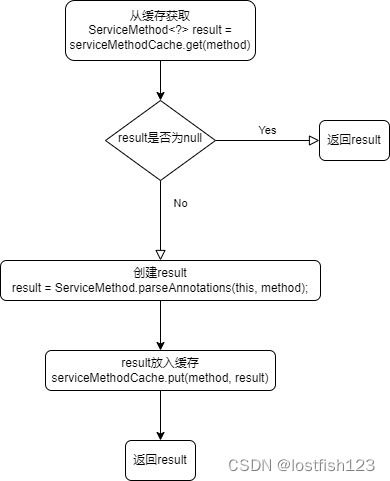retrofit系列-ServiceMethod创建流程
1.使用retrofit的例子
- 创建一个interface RetrofitServiceApi
public interface RetrofitServiceApi {
@POST("/user/get/userinfo")
Call> requestUserInfo(@Query("token") String token);
} - 调用Retrofit的create方法来创建 RetrofitServiceApi对象后,调用requestUserInfo方法
//调用RetrofitServiceApi的requestUserInfo方法
public Call> requestUserInfo(String token) {
return mRetrofit.create(RetrofitServiceApi.class).requestUserInfo(token);
} 2.Retrofit.create
- 调用Proxy.nexProxyInstance创建动态代理对象
- 调用参数的service的方法的时候,会触发invoke方法的执行
//retrofit\src\main\java\retrofit2\Retrofit.java
public final class Retrofit {
public T create(final Class service) {
validateServiceInterface(service); //判断是不是接口,不是的话就抛出异常
return (T)
Proxy.newProxyInstance(
service.getClassLoader(),
new Class[] {service},
new InvocationHandler() {
private final Object[] emptyArgs = new Object[0];
@Override
public @Nullable Object invoke(Object proxy, Method method,
@Nullable Object[] args) throws Throwable {
// If the method is a method from Object then defer
//to normal invocation.
//获取声明该方法的类的 Class 对象
if (method.getDeclaringClass() == Object.class) {
return method.invoke(this, args);
}
args = args != null ? args : emptyArgs;
Platform platform = Platform.get();
return platform.isDefaultMethod(method)
? platform.invokeDefaultMethod(method, service, proxy, args)
: loadServiceMethod(method).invoke(args);
}
});
}
} 3.Retrofit.loadServiceMethod
先从缓存里获取ServiceMethod
找到,返回结果;
没找到,调用ServiceMethod.parseAnnotations创建ServiceMethod后,放入缓存,返回结果;
public final class Retrofit {
private final Map> serviceMethodCache = new
ConcurrentHashMap<>();
ServiceMethod loadServiceMethod(Method method) {
ServiceMethod result = serviceMethodCache.get(method);//从缓存获取
if (result != null) {//缓存中已经有的话,就返回缓存中获取的
return result;
}
synchronized (serviceMethodCache) {//这里加锁了
//很严谨,这里再获取了一次
result = serviceMethodCache.get(method);
if (result == null) {
result = ServiceMethod.parseAnnotations(this, method); //生成ServiceMethod
serviceMethodCache.put(method, result);//放入方法缓存
}
}
return result;
}
} 4.ServiceMethod.parseAnnotations 创建ServiceMethod
//retrofit\src\main\java\retrofit2\ServiceMethod.java
abstract class ServiceMethod {
static ServiceMethod parseAnnotations(Retrofit retrofit, Method method) {
//4.1
RequestFactory requestFactory = RequestFactory.parseAnnotations(retrofit, method);
//省略部分代码
//4.2
return HttpServiceMethod.parseAnnotations(retrofit, method, requestFactory);
}
}
4.1.RequestFactory.parseAnnotations
//retrofit\src\main\java\retrofit2\RequestFactory.java
final class RequestFactory {
//所以一个Method对应一个RequestFactory
static RequestFactory parseAnnotations(Retrofit retrofit, Method method) {
return new Builder(retrofit, method).build();
}
}4.1.1.new Builder
//retrofit\src\main\java\retrofit2\RequestFactory.java
final class RequestFactory {
static final class Builder {
final Annotation[] methodAnnotations;
final Annotation[][] parameterAnnotationsArray;
Builder(Retrofit retrofit, Method method) {
this.retrofit = retrofit;
this.method = method;
this.methodAnnotations = method.getAnnotations();
this.parameterTypes = method.getGenericParameterTypes();
this.parameterAnnotationsArray = method.getParameterAnnotations();
}
}
}4.1.2.build
//retrofit\src\main\java\retrofit2\RequestFactory.java
final class RequestFactory {
static final class Builder {
RequestFactory build() {
for (Annotation annotation : methodAnnotations) {
parseMethodAnnotation(annotation); //4.1.2.1
}
//省略部分代码
return new RequestFactory(this);
}
}
}4.1.2.1.parseMethodAnnotation
根据annotation来确定调用parseHttpMethodAndPath方法时各个参数的值
//retrofit\src\main\java\retrofit2\RequestFactory.java
final class RequestFactory {
static final class Builder {
private void parseMethodAnnotation(Annotation annotation) {
//省略部分代码
if (annotation instanceof POST) {
parseHttpMethodAndPath("POST", ((POST) annotation).value(), true);
}
}
}
}//retrofit\src\main\java\retrofit2\RequestFactory.java
final class RequestFactory {
static final class Builder {
@Nullable String httpMethod;
boolean hasBody;
@Nullable String relativeUrl;
@Nullable Set relativeUrlParamNames;
private void parseHttpMethodAndPath(String httpMethod, String value, boolean
hasBody){
this.httpMethod = httpMethod;
this.hasBody = hasBody;
if (value.isEmpty()) { //上面例子的value是""
return;
}
//如果不是"",会继续解析URL参数
this.relativeUrl = value;
this.relativeUrlParamNames = parsePathParameters(value);
}
static Set parsePathParameters(String path) {
Matcher m = PARAM_URL_REGEX.matcher(path);
Set patterns = new LinkedHashSet<>();
while (m.find()) {
patterns.add(m.group(1));
}
return patterns;
}
}
} 4.2.HttpServiceMethod.parseAnnotations
abstract class HttpServiceMethod extends ServiceMethod {
static HttpServiceMethod parseAnnotations(
Retrofit retrofit, Method method, RequestFactory requestFactory) {
//1.创建CallAdapter
CallAdapter callAdapter =
createCallAdapter(retrofit, method, adapterType, annotations);
//2.创建Converter
Converter responseConverter =
createResponseConverter(retrofit, method, responseType);
okhttp3.Call.Factory callFactory = retrofit.callFactory;
//创建HttpServiceMethod
if (!isKotlinSuspendFunction) {
return new CallAdapted<>(requestFactory, callFactory, responseConverter,
callAdapter);
} else if (continuationWantsResponse) {
//noinspection unchecked Kotlin compiler guarantees ReturnT to be Object.
return (HttpServiceMethod)
new SuspendForResponse<>(
requestFactory,
callFactory,
responseConverter,
(CallAdapter>) callAdapter);
} else {
//noinspection unchecked Kotlin compiler guarantees ReturnT to be Object.
return (HttpServiceMethod)
new SuspendForBody<>(
requestFactory,
callFactory,
responseConverter,
(CallAdapter>) callAdapter,
continuationBodyNullable,
continuationIsUnit);
}
}
} 4.3.CallAdapted、SuspendForResponse、SuspendForBody 的区别
在 Retrofit 中,`CallAdapted`、`SuspendForResponse` 和 `SuspendForBody` 主要涉及到 Retrofit 如何处理异步调用和响应处理。
CallAdapted:
- `CallAdapted` 通常指的是标准的同步 Retrofit 调用。
- 它表示以同步方式执行的调用,这意味着调用在当前线程上进行,并且会一直阻塞,直到收到响应。
- 这是使用 Retrofit 进行 API 调用的传统方式。
SuspendForResponse:
- `SuspendForResponse` 表示一个挂起函数,用于处理异步调用,该函数的返回类型是 `Response
`,其中 `T` 是 API 响应的类型。 - 使用挂起函数可以更方便地在异步环境中处理响应,而无需使用回调或其他异步编程模式。
SuspendForBody:
- `SuspendForBody` 也是一个挂起函数,但是它的返回类型是 `T`,即 API 响应的实际数据类型。
- 这种方式更关注处理响应体的内容,而不是完整的响应对象。
总体而言,这些类型主要用于在 Retrofit 中以同步或异步的方式处理 API 调用和响应。`SuspendForResponse` 和 `SuspendForBody` 是与 Kotlin 挂起函数一起使用的,使得在异步场景中更容易进行处理。
